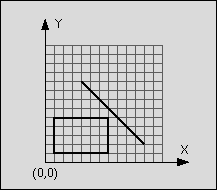poj1410判断线段与矩形是否相交(判断线段相交)
2015-07-07 09:58
411 查看
Intersection
Description
You are to write a program that has to decide whether a given line segment intersects a given rectangle.
An example:
line: start point: (4,9)
end point: (11,2)
rectangle: left-top: (1,5)
right-bottom: (7,1)

Figure 1: Line segment does not intersect rectangle
The line is said to intersect the rectangle if the line and the rectangle have at least one point in common. The rectangle consists of four straight lines and the area in between. Although all input values are integer numbers, valid intersection points do not
have to lay on the integer grid.
Input
The input consists of n test cases. The first line of the input file contains the number n. Each following line contains one test case of the format:
xstart ystart xend yend xleft ytop xright ybottom
where (xstart, ystart) is the start and (xend, yend) the end point of the line and (xleft, ytop) the top left and (xright, ybottom) the bottom right corner of the rectangle. The eight numbers are separated by a blank. The terms top left and bottom right do
not imply any ordering of coordinates.
Output
For each test case in the input file, the output file should contain a line consisting either of the letter "T" if the line segment intersects the rectangle
or the letter "F" if the line segment does not intersect the rectangle.
Sample Input
Sample Output
(线段在矩形里面属于相交)
题意:给出的矩形的坐标不一定左上右下,需要自己判断
(1)判断线段与线段之间是否相交
1、两线段不在同一直线上

将其中一条线段看成直线,然后就是判断直线与线段之间的关系,
将另一条线段看成直线,当两种情况的叉积都为负时说明两线段相交
2、两线段在同一直线上(相交和不相交两种情况)
$8V9MBHQ{MB8$DPE}B.png)
$8V9MBHQ{MB8$DPE}B.png)
当其中一条线段端点的 较大横坐标(较大纵坐标) 小于 另一条线段端点的 较小横坐标(较小纵坐标)说明两线段不相交,否则相交
Description
You are to write a program that has to decide whether a given line segment intersects a given rectangle.
An example:
line: start point: (4,9)
end point: (11,2)
rectangle: left-top: (1,5)
right-bottom: (7,1)

Figure 1: Line segment does not intersect rectangle
The line is said to intersect the rectangle if the line and the rectangle have at least one point in common. The rectangle consists of four straight lines and the area in between. Although all input values are integer numbers, valid intersection points do not
have to lay on the integer grid.
Input
The input consists of n test cases. The first line of the input file contains the number n. Each following line contains one test case of the format:
xstart ystart xend yend xleft ytop xright ybottom
where (xstart, ystart) is the start and (xend, yend) the end point of the line and (xleft, ytop) the top left and (xright, ybottom) the bottom right corner of the rectangle. The eight numbers are separated by a blank. The terms top left and bottom right do
not imply any ordering of coordinates.
Output
For each test case in the input file, the output file should contain a line consisting either of the letter "T" if the line segment intersects the rectangle
or the letter "F" if the line segment does not intersect the rectangle.
Sample Input
1 4 9 11 2 1 5 7 1
Sample Output
F
(线段在矩形里面属于相交)
题意:给出的矩形的坐标不一定左上右下,需要自己判断
(1)判断线段与线段之间是否相交
1、两线段不在同一直线上

将其中一条线段看成直线,然后就是判断直线与线段之间的关系,
将另一条线段看成直线,当两种情况的叉积都为负时说明两线段相交
2、两线段在同一直线上(相交和不相交两种情况)
$8V9MBHQ{MB8$DPE}B.png)
$8V9MBHQ{MB8$DPE}B.png)
当其中一条线段端点的 较大横坐标(较大纵坐标) 小于 另一条线段端点的 较小横坐标(较小纵坐标)说明两线段不相交,否则相交
#include<stdio.h>
#include<algorithm>
using namespace std;
struct point{
double x,y;
}L1,L2;
struct line{
point A,B;
}L[5];
double cal(point A,point B,point C)
{
return (C.x-A.x)*(B.y-A.y)-(B.x-A.x)*(C.y-A.y);
}
int cross(point C,point D)
{
double d1,d2,d3,d4;
d1=cal(L1,L2,C);
d2=cal(L1,L2,D);
d3=cal(C,D,L1);
d4=cal(C,D,L2);
if(d1==0 && d2==0 && d3==0 && d4==0) //两线段在同一直线上
{
if(max(L1.x,L2.x)<min(C.x,D.x)||max(C.x,D.x)<min(L1.x,L2.x))
return 0;
else if(max(L1.y,L2.y)<min(C.y,D.y)||max(C.y,D.y)<min(L1.y,L2.y))
return 0;
else return 1;
}
if(d1*d2<0 && d3*d4<0)
{
return 1;
}
return 0;
}
int fun1(double x1,double y1,double x2,double y2)
{
double xmin=x1<x2?x1:x2;
double xmax=x1>x2?x1:x2;
double ymin=y1<y2?y1:y2;
double ymax=y1>y2?y1:y2;
double Lxmin=L1.x<L2.x?L1.x:L2.x;
double Lxmax=L1.x>L2.x?L1.x:L2.x;
double Lymin=L1.y<L2.y?L1.y:L2.y;
double Lymax=L1.y>L2.y?L1.y:L2.y;
if(Lxmin>=xmin&&Lxmax<=xmax&&Lymin>=ymin&&Lymax<=ymax)
return 1;
else return 0;
}
void fun(double x1,double y1,double x2,double y2)
{
for(int i=0; i < 4; i++)
{
if(cross(L[i].A,L[i].B)==1)
{
printf("T\n");
return ;
}
}
if(fun1(x1,y1,x2,y2)==1)
{
printf("T\n");
return ;
}
printf("F\n");
}
int main()
{
int n;
double x1,y1,x2,y2;
scanf("%d",&n);
while(n--)
{
scanf("%lf%lf%lf%lf",&L1.x,&L1.y,&L2.x,&L2.y);
scanf("%lf%lf%lf%lf",&x1,&y1,&x2,&y2);
L[0].A.x=x1; L[0].A.y=y1;
L[0].B.x=x2; L[0].B.y=y1;
L[1].A.x=x2; L[1].A.y=y1;
L[1].B.x=x2; L[1].B.y=y2;
L[2].A.x=x1; L[2].A.y=y2;
L[2].B.x=x2; L[2].B.y=y2;
L[3].A.x=x1; L[3].A.y=y1;
L[3].B.x=x1; L[3].B.y=y2;
fun(x1,y1,x2,y2);
}
return 0;
}
相关文章推荐
- The method getServletContext() is undefined for the type HttpServletRequest
- centos yum安装ffmpeg
- SQLSERVER如何获取一个数据库中的所有表的名称、一个表中所有字段的名称
- 原型链
- #笔记#圣思园 JavaWeb 第23讲——JavaBean
- Check Point R 77.30 ReleaseNotes 2015年5月27日更新版本
- sql
- svn 服务器搭建 以及ecilpse svn布局
- NOIP2011观光公交
- windows下webrtc的编译 2015
- SqlDataAdapter.Update批量数据更新
- char*,const char*和string的相互转换
- activiti-tomcat
- iOS开发之多表视图滑动切换示例(仿"头条"客户端)---优化篇
- FreeMarker如何输出特殊含义字符
- 记录SQL Server2008日志文件损坏的恢复过程
- python 进程池Pool
- Extension Method[上篇]
- 使用Hyper-V集群和存储功能以达到HA
- 一次完整的HTTP事务过程分析
